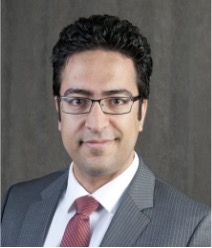Webinar Series - MARCH - Traffic Control in the Era of Connected Automated Vehicles
Connected automated vehicles (CAVs) are expected to bring significant changes to how we travel and how traffic control devices operate. It is hypothesized that traffic lights may become obsolete and can be removed from intersections when all vehicles are both connected and automated. Some changes in traffic light systems may be necessary to accommodate the transition to a road system in which all vehicles are automated, and this means changing a technology that has been around for more than 100 years. In this talk, we introduce a new traffic control paradigm: using automated vehicles as mobile traffic controllers in cooperation with traffic signal controllers. In this concept, automated vehicles can create groups of human-driven vehicles, negotiate the right of way with each other, and navigate human-driven vehicles through the intersection during a new phase called the white phase. This happens only when enough automated vehicles are present in the intersection neighborhood, otherwise, typical green, yellow, and red phases are used. The simulation analysis has been very promising, and the new paradigm resulted in total delay reductions ranging from 7 percent to 96 percent when the automated vehicle market penetration rate increases from 10 percent up to 100 percent. This talk will also cover controlling CAVs in roundabouts and signal-free intersections.
Date and Time
Location
Hosts
Registration
-
 Add Event to Calendar
Add Event to Calendar
Speakers
 Ali Hajbabaie of NC State University
Ali Hajbabaie of NC State University
Traffic Control in the Era of Connected Automated Vehicles
Connected automated vehicles (CAVs) are expected to bring significant changes to how we travel and how traffic control devices operate. It is hypothesized that traffic lights may become obsolete and can be removed from intersections when all vehicles are both connected and automated. Some changes in traffic light systems may be necessary to accommodate the transition to a road system in which all vehicles are automated, and this means changing a technology that has been around for more than 100 years. In this talk, we introduce a new traffic control paradigm: using automated vehicles as mobile traffic controllers in cooperation with traffic signal controllers. In this concept, automated vehicles can create groups of human-driven vehicles, negotiate the right of way with each other, and navigate human-driven vehicles through the intersection during a new phase called the white phase. This happens only when enough automated vehicles are present in the intersection neighborhood, otherwise, typical green, yellow, and red phases are used. The simulation analysis has been very promising, and the new paradigm resulted in total delay reductions ranging from 7 percent to 96 percent when the automated vehicle market penetration rate increases from 10 percent up to 100 percent. This talk will also cover controlling CAVs in roundabouts and signal-free intersections.
Biography:
Dr. Ali Hajbabaie received his B.Sc. and M.Sc. degrees in Civil Engineering in 2003 and 2006, respectively from Sharif University of Technology, Tehran, Iran. He obtained a second M.Sc. in Industrial Engineering (2011) and a Ph.D. in Civil Engineering from the University of Illinois at Urbana – Champaign. Dr. Hajbabaie has been an assistant professor in the Civil, Construction, and Environmental Engineering Department at NC State University Since Fall 2019. He was an assistant professor in the Department of Civil and Environmental Engineering at Washington State University from October 2014 to August 2019. Dr. Hajbabaie has served as the Secretary of Work Zone Traffic Control standing committee of the Transportation Research Board (TRB) of the National Academies of Sciences, Engineering, and Medicine from 2014 to 2019 and as the Chair of the Asset Management Subcommittee of Traffic Signal Systems Committee of the TRB. Dr. Hajbabaie’s activities contribute to the advancement of real-time optimization of large-scale complex engineering systems represented by models with a high degree of realism. He is an associate editor of IEEE Transactions on Intelligent Transportation Systems. Dr. Hajbabaie is the recipient of the junior outstanding researcher from the Department of Civil and Environmental Engineering at Washington State University. He is the recipient of the best paper award from the work zone traffic control committee of the transportation research board.
Agenda
Mechatronics and Automation for Revitalizing Critical infrastructure Health (MARCH) - Moving from Research to Application
The IEEE Industrial Electronics Society Chapter of the Eastern North Carolina Section is hosting a multi-disciplinary webinar series titled, “Mechatronics and Automation for Revitalizing Critical infrastructure Health (MARCH) - Moving from Research to Application”. The speakers will be focusing on applied research and development in automation of sensors, actuators and intelligent decision making to improve, automate or smarten critical infrastructure systems such as power, communication, water, transportation, etc. for fault detection, diagnosis and mitigation, and interconnected collaborative operation. The goal of the webinar series is to build and expand connections between faculty and to foster new faculty-industry relationships to widen the applicability of their research to a larger industry/academic audience. This webinar also aims to broaden the research horizon and facilitate the integration of scientific aspects that were previously not considered as prominent factors for the operation of certain critical infrastructure. Attendees will have the opportunity to interact with the speakers and other attendees to build partnerships to participate in funding opportunities and collaborative interdisciplinary research.

